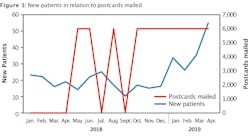As an owner-dentist, what do you do when your office manager comes to you and basically says, “Hey, let’s spend a lot of money on this money pit . . . “?
If you can imagine that moment, then you can relate well to Jeffrey S. Kleinheinz, DDS, (aka Dr. K) and Jay Yuckel, the team in charge at Kleinheinz Dentistry in Charlotte, North Carolina. I sat down with both of them recently to discuss the marketing journey that took Dr. K from direct mail–phobic to newfound believer. (For full disclosure, Kleinheinz Dentistry is one of my clients.)
Flash back to the beginning of 2018, when the pair found themselves in this situation. Jay, Dr. K’s office manager since 2017, finally broached a “toxic” subject—direct mail. It was a marketing medium Dr. K did not look favorably upon. Here’s why: Jay had already convinced Dr. K months before, in late 2017, to give direct mail a shot, and it was a big ask. For most of his dental career, Dr. K had been a conservative marketer and (mostly) content business owner.
Dr. K: “The practice started pretty much from scratch in 2000, and we had just been kind of humming along. Revenue started to go flat or decline for three or four years, maybe five years, so in September of 2016, I started looking at consultants and started marketing and changing some of the things we did. I thought, ‘At my age, one more kick in the ass with a consultant and maybe we can really move the needle and change something.’”
A big change came in early 2017 with the arrival of Jay, who had racked up 15 years of experience in practice management. With a previous employer, she had taken the team from just three staff (herself, the dentist, and a dental assistant) to 22 staff and two locations.
Jay: “I’d definitely had experience with what marketing could do. Postcards, word of mouth, a good reputation, being involved in the community—they’re all really impactful for a practice.”
Not long after being installed as office manager, Jay began to lobby for a direct-mail campaign to drive new patients and growth. Jay’s take on direct mail was backed up by their consulting company at the time, which gave Dr. K the confidence to give it a go. This consultant directed them to a major nationwide direct-mail company. (Not mine.)
In late 2017, with the support of their consultant and at the behest of Jay, Dr. K green-lighted a newsletter-driven mail campaign that lasted about three months.
It was a total disaster.
Dr. K: “We figured we needed two new patients a month to break even on the cost, but it didn’t get us anywhere. So I had a really bad taste in my mouth about doing direct mail, and I was really reluctant when Jay said to me, ‘Hey, let’s spend a lot of money on this money pit.’ Or at least that’s what I heard.”
Jay: “It was a disappointing journey. Yes, we did get some new patients. But the quality of patient wasn’t ideal for what we do here.”
The two reacted differently to the setback, which amounted to roughly $5,000 in losses after all was said and done. Jay, ever ready to roll with the punches, wanted to change gears and try again. Dr. K, on the other hand, was less than eager.
Jay: “I just feel like people shouldn’t get discouraged if something doesn’t go right. Instead, keep on moving forward.”
Going forward meant that Dr. K and Jay had to move past both the mailing company they had worked with and the consulting company that had referred them. Jay struck out on her own and followed her instincts. She reached out to Zach, one of my employees.
Jay: “I had worked with Zach before on a year-long campaign at another practice. So I knew that the ramifications of direct mail were pretty good, and that the ROI was good.”
But how did Jay convince Dr. K to trust her again, after the last campaign left his pocket $5,000 lighter?
Jay: “I definitely had to put my word there . . . Basically, we sat down together and had an honest conversation. I looked at Dr. K and I said, ‘OK, we did a marketing campaign that was too broad. We targeted everybody out there, the coupon was extremely low, and it didn’t work. But we’re in an area that is affluent. So, let’s narrow it down by zip code and by household income, and I know who can narrow it down for us and make the campaign successful.’”
Zach worked with Jay on a new campaign that would ensure they didn’t make the same mistakes, but Dr. K was still trigger shy. He agreed to the order—and then canceled almost immediately.
Jay persisted. She was so confident that the new approach would work that she couldn’t give up. She negotiated a deal with Zach that she knew Dr. K would be crazy to pass up. He agreed with Jay’s proposal to closely track all leads and revenue from those leads and to mail consistently for six months.
So how did the new direct-mail campaign fare?
Jay: “This is by far the most successful postcard campaign I have ever done my 16-year career. We are so happy with the results.”
Dr. K: “Once we saw the net results, which accounted for the discounts we offered to those new patients and what we spent on the campaign, it was easy for me to see that we were still coming out ahead.”
Let’s get into the specifics of their current campaign:
• Mailing list: highest income mailing routes within a three-mile radius of the practice
• Mailing schedule: 6,000 postcards mailed monthly (for the most part)
• Average new patients from January to April 2018 (no mailings): 20 new patients per month
• Average new patients from January to April 2019 (ongoing mailings): 37.5 new patients per month
• Average production from January to April 2018: $85,809
• Average production from January to April 2019: $115,807
That’s an 87.5% increase in new patients and a 34.9% increase in production year over year. You can see the huge climb in monthly new-patient numbers in Figure 1. I don’t know a single dentist who wouldn’t be pleased with that upward new-patient trend.
You can also see the impact that regular, consistent mailings have on response—new patients started to climb steadily only after the practice’s mailings became consistent. New patients started to climb in mid-2018 with two consistent mailings in May and June, but the inconsistency ultimately overcame the momentum and new-patient numbers fell again.
This is vitally important to remember with direct mail: you have to be consistent.
This campaign featured another advantage: built-in Facebook, Instagram, and Google ads that ran concurrently with their postcards and with a cohesive, coordinated brand and message. This meant additional exposure for a fraction of the price. Here are the clicks and impressions as of June 20, 2019:
• Facebook and Instagram ad impressions: 74,555
• Facebook and Instagram ad clicks: 363
• Google ad impressions: 438,411
• Google ad clicks: 3,508
With business booming and his appointment book full weeks (if not months) in advance, Dr. K has expanded his team to keep up with demand.
Dr. K: “We’ve added two new full-time staff, a hygienist and a dental assistant, and then another part-time dental assistant. And as long as we can find the right personnel, I want to get some younger associates in there this year to help me out.”
Thanks to these two, Kleinheinz Dentistry has already come a long way from where it started as just one of 19 nearby dental practices eking out a profit. They are beginning to dominate their market and have eyes on the future.
Jay: “I’m working with somebody who was very conservative and very content with how things were before. And now, his perspective and frame of mind has changed to, ‘Yes, we can do it.’ The sky’s the limit.”
This time around, Jay has the full (and well-earned) support of her boss, and their goals are in sync.
Dr. K: “I was comfortable before, and we were just kind of coasting, but now there’s definitely an emphasis on growth.”
Author’s note: If you’d like to see Dr. K and Jay discuss their direct-mail journey in person, check out their video case study at postcardmania.com/dr-k.
JOY GENDUSA is the founder and CEO of PostcardMania. Using just postcards, a phone, and a computer, Joy built PostcardMania from a one-person start-up into an industry leader. PostcardMania serves 86,537 clients, including 6,288 dentists. Need help promoting your practice? Call one of PostcardMania’s dental marketing consultants at (844) 269-1836 or email Joy at [email protected].








